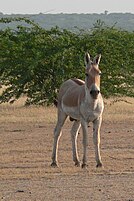Indian Wild Ass Sanctuary
23°09′10″N71°23′44″E/ 23.152739°N 71.395678°E
| Indian Wild Ass Sanctuary | |
|---|---|
| Wild Ass Nature Education Camp | |
 Khurgrazing at the Indian Wild Ass Sanctuary,Little Rann of Kutch. | |
| Location | Kutchh,Gujarat,India |
| Nearest city | Ahmedabad |
| Area | 4954 km2 |
| Established | 1972 |
| World Heritage site | UNESCO Tentative List |
| Website | GujaratTourism |

TheIndian Wild Ass Sanctuary,orWild Ass Wildlife Sanctuary,is located in theLittle Rann of Kutchin the state ofGujarat,India,spread over an area of 4954 km².[1]
The Wild Ass Wildlife Sanctuary was established under theWildlife Protection Actof 1972 as one of the last bastions for the endangeredIndian wild ass(Equus hemionus khur)—calledkhurorgodhkhurin theGujaratilanguage—, a southernsubspeciesofE. hemionus,theAsiatic wild ass(oronager).
Geography
[edit]TheRann of Kutchis a sealine desert. Duringmonsoon,the Rann (Gujaratifordesert) gets flooded for a period of about one month and is dotted with about 74 elevated plateaus or islands, locally called 'bets'. Thesebetsare covered with grass and feed the population of around 2100 animals.[2]
Species found
[edit]The sanctuary is also a habitat for many other endemic species of animals and migratory birds. According to data submitted to theUNESCOWorld Heritage Centre,[3]the sanctuary's rich biodiversity includes
- at least 70,000 individual bird nests and pairs;
- at least 30 species ofreptile,with twoturtles,14lizardsand 12snakespecies, as well as themugger crocodile;
- four species ofamphibian;
- and about 90 species ofinvertebrates—25 species ofzooplankton,oneannelid,fourcrustaceans(includingMetapenaeuskutchensis,a type ofprawn), 24insects,12molluscsand 27arachnids.

Threats
[edit]The main threat faced by the sanctuary is the illegalsalt panning[4]activity in the area. 25% of India's salt supply comes from panning activity in the area.[5]
Biosphere Reserve — World Heritage Site
[edit]The reserve was nominated by the Forest Department to be abiosphere reserve,which are areas of terrestrial and coastalecosystemsinternationally recognised within the framework of UNESCO's Man and Biosphere (MAB) programme. The aim of the programme is to focus on conservingbiological diversity,and the research, monitoring and providing of sustainable development models. The proposal was sent to and listed atUNESCO.[6][7][8]
Wildlife Sanctuaries and Reserves of Kutch
[edit]From the city ofBhujvariousecologicallyrich andwildlife conservationareas of the Kutch /Kachchh districtcan be visited such as Indian Wild Ass Sanctuary,Kutch Desert Wildlife Sanctuary,Narayan Sarovar Sanctuary,Kutch Bustard Sanctuary,Banni Grasslands ReserveandChari-Dhand Wetland Conservation Reserveetc..
Gallery
[edit]-
A group of female khur breaking into a run.
-
Alpha male of a herd.
-
Nilgaiherd at Wild Ass Sanctuary, LRK.
-
Landscape of Wild Ass Sanctuary.
-
Indian Wild Ass
See also
[edit]References
[edit]- ^"Wildlife Sanctuaries".wiienvis.nic.in.Archivedfrom the original on 2017-02-23.Retrieved2017-04-24.
- ^"Indian Wild Ass Sanctuary".The Hindu.Chennai, India. 27 February 2006. Archived fromthe originalon 2007-01-22.Retrieved2006-09-13.
- ^"Wild Ass Sanctuary, Little Rann of Kutch".UNESCO World Heritage Centre.Archivedfrom the original on 2022-05-16.Retrieved2006-09-13.
- ^The salt-panners of the little Rann;kuensel online; Nov 16, 2009; asiaone news; Singapore Press Holdings
- ^"Rann of Kutchh Wild Ass Sanctuary, Kutchh".Archived fromthe originalon 2006-10-17.Retrieved2006-09-13.
- ^Centre, UNESCO World Heritage."Wild Ass Sanctuary, Little Rann of Kutch".UNESCO World Heritage Centre.Archivedfrom the original on 2022-05-16.Retrieved2019-12-26.
- ^Kaushik, Himanshu (July 22, 2008)."Kutch gets biosphere reserve status".The Economic Times.Archivedfrom the original on April 30, 2019.RetrievedApril 27,2019.
- ^Kutch’s wild ass habitat may soon get heritage labelArchived2023-03-05 at theWayback Machine(2 Page article online); by DP Bhattacharya; Jul 26, 2007; Indian Express Newspaper
Further reading
[edit]- Wild asses population rises by 4%;TNN; 11 April 2009; Times of India
- Wild Ass vulnerable to flu;by TNN; 9 April 2009; Times of India
- Wild ass census to kick off from April 5;TNN; 31 March 2009; Times of India
- Bleak future for traditional salt;by Anosh Malekar; February 21, 2009; Courtesy: Infochange News & Features; ComodittyOnline
- Wild ass robs agarias' livelihood;February 15, 2007; Rediff India Abroad
- Indian Wild Ass Sanctuary;SANCTUARY SPOTLIGHT; Mar 04, 2006; The Hindu, Online edition of India's National Newspaper. Also posted atIndian Wild Ass Sanctuary
- Wild ass population shows upward trend;TNN; 3 April 2004; Times of India
- Japanese duo does donkey work in Rann - ‘‘The female donkeys are left by the maldhari’s on the island of Plaswa village in the Rann of Kutch for about three months during the monsoon. Here, the Wild Ass, a protected species, breed with the female donkeys leading to the birth of hybrid donkeys which are taller than their mothers and wilder than their fathers,’’ says Dr R Kimura who has been a visiting researcher at the Equine Museum of Japan for the past two decades.;by Rupam Jain; November 3, 2003; Indian Express Newspaper. Also see[1]
- Officials gear up for wild ass census;by TNN; 28 November 2003; Times of India
- Wild ass being robbed of its run of the Little Rann[permanent dead link];by ANAND SUNDAS; March 8, 1999; Indian Express Newspaper
External links
[edit]- Wild ASS Sanctuary&Wild Life - National Parks & Wildlife Sanctuaries - Wild ASS Sanctuary;Official website: Forests & Environment Department; State Government of Gujarat, India





